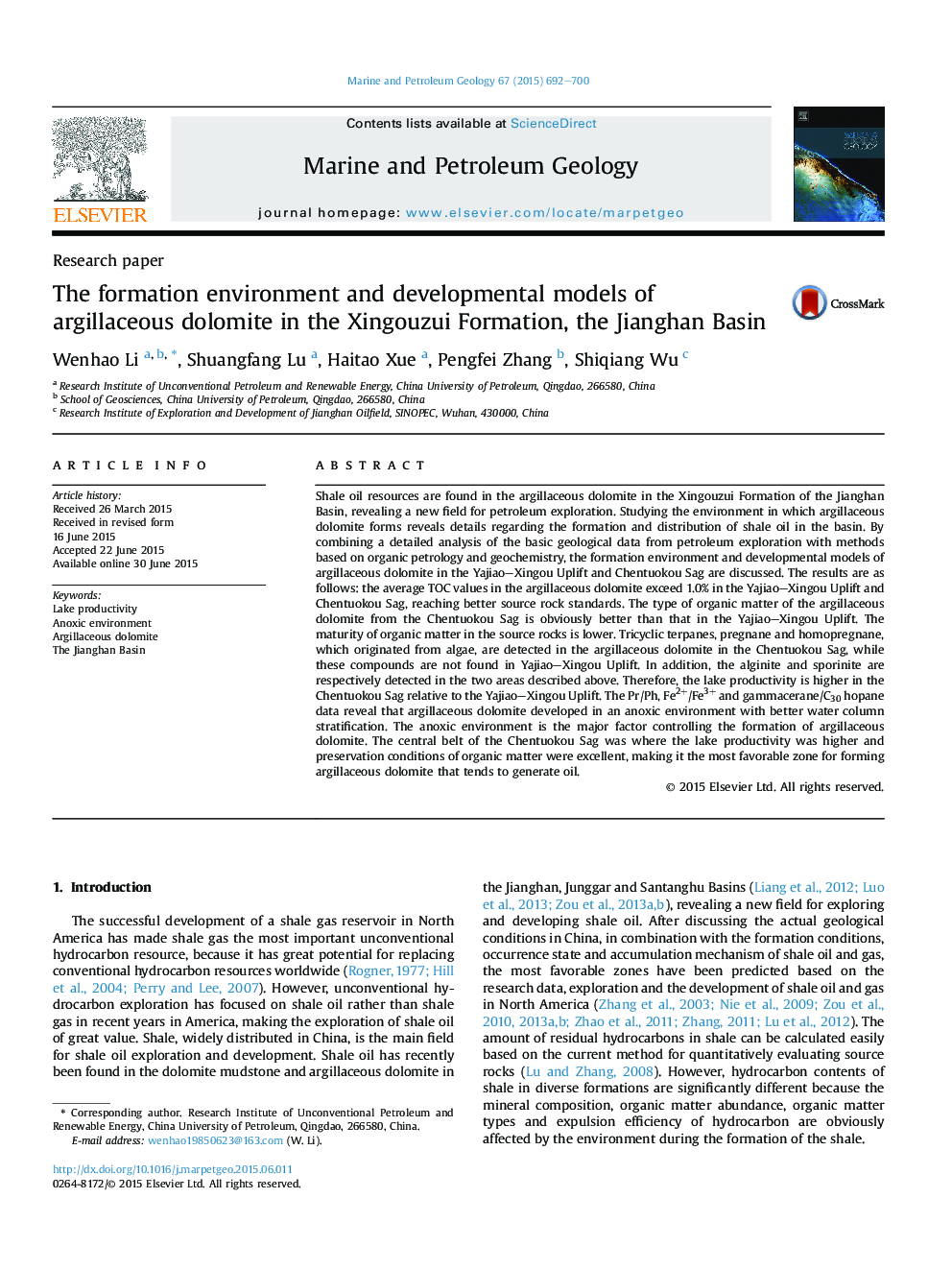| Article ID | Journal | Published Year | Pages | File Type |
|---|---|---|---|---|
| 6434975 | Marine and Petroleum Geology | 2015 | 9 Pages |
â¢Oil potential of the argillaceous dolomite is identified.â¢The formation environment of the argillaceous dolomite is reconstructed.â¢The main controlling factor of the argillaceous dolomite formation is revealed.â¢The developmental model of the argillaceous dolomite is proposed.
Shale oil resources are found in the argillaceous dolomite in the Xingouzui Formation of the Jianghan Basin, revealing a new field for petroleum exploration. Studying the environment in which argillaceous dolomite forms reveals details regarding the formation and distribution of shale oil in the basin. By combining a detailed analysis of the basic geological data from petroleum exploration with methods based on organic petrology and geochemistry, the formation environment and developmental models of argillaceous dolomite in the Yajiao-Xingou Uplift and Chentuokou Sag are discussed. The results are as follows: the average TOC values in the argillaceous dolomite exceed 1.0% in the Yajiao-Xingou Uplift and Chentuokou Sag, reaching better source rock standards. The type of organic matter of the argillaceous dolomite from the Chentuokou Sag is obviously better than that in the Yajiao-Xingou Uplift. The maturity of organic matter in the source rocks is lower. Tricyclic terpanes, pregnane and homopregnane, which originated from algae, are detected in the argillaceous dolomite in the Chentuokou Sag, while these compounds are not found in Yajiao-Xingou Uplift. In addition, the alginite and sporinite are respectively detected in the two areas described above. Therefore, the lake productivity is higher in the Chentuokou Sag relative to the Yajiao-Xingou Uplift. The Pr/Ph, Fe2+/Fe3+ and gammacerane/C30 hopane data reveal that argillaceous dolomite developed in an anoxic environment with better water column stratification. The anoxic environment is the major factor controlling the formation of argillaceous dolomite. The central belt of the Chentuokou Sag was where the lake productivity was higher and preservation conditions of organic matter were excellent, making it the most favorable zone for forming argillaceous dolomite that tends to generate oil.
Graphical abstractThe developmental model of the argillaceous dolomite in the Xingouzui Formation in the Jianghan Basin. Argillaceous dolomite in the Yajiao-Xingou Uplift: Due to the influence of the Hanshui River, large-scale delta deposits were observed in the northern portion of the uplift, providing abundant terrigenous organic matter. However, lake productivity could be diluted by mass of detrital materials delivered by the river-delta system. The source rocks only could be formed in brackish to semi-saline environments where organic matter preserving conditions was favorable. Source rocks in this conditions could generate oil and gas. Argillaceous dolomite in the Chentuokou Sag: Shallow lake environment was developed in the slope of the Chentuokou Sag, the organic matter derived from both lower aquatic organisms and higher terrestrial plants in this area. Although the lake productivity was lower, abundant terrestrial organic matter could be brought from the Jiangnan Uplift, to the south of the Jianghan Basin. Source rocks in this zone could be formed, which can generate both oil and gas. Semi-saline to hypersaline environment was developed in the central depression belt of the Chentuokou Sag. The argillaceous dolomite in the area have excellent hydrocarbon potential owing to the better organic matter preservation conditions. In shallow to semi-deep lake environments, organic matter originated primarily from lower aquatic organisms, So source rocks in this area have better oil-generation potential.Download full-size image
